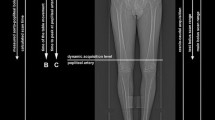Abstract
The aim of this study was to assess the role of three-dimensional rotational venography (3D RV) supplementary to two-dimensional (2D) digital subtraction venography (DSV) in evaluation of the left iliac vein in patients with chronic lower limb edema. We reviewed 34 patients with chronic lower limb edema who had undergone bilateral iliac 2D DSV and 3D RV of the left common iliac vein and had surgery in our institution. The presence, anatomical location, and size of the venous narrowing were assessed. Stenosis was defined as luminal narrowing of 50% or more compared with the prestenotic or poststenotic lumen by visual assessment. A measured pressure gradient of 2 mm Hg or more at surgery was considered a positive result. The diagnostic accuracy was higher for the 3D images (88.2%) than for the 2D images alone (70.6%). 3D images provided higher sensitivity (90%) than the 2D images alone (66.7%). The 2D images alone had excellent specificity (100%) and positive predictive value (100%) in the diagnosis of venous narrowing. 2D DSV images provide specificity in diagnosis of venous stenosis of the left iliac vein in patients with chronic lower limb edema. In patients with negative 2D images, additional 3D RV leads to higher diagnostic sensitivity, thereby providing a powerful tool for planning surgical and endovascular treatment.


Similar content being viewed by others
References
Ciocon JO, Fernandez BB, Ciocon DG (1993) Leg edema: clinical clues to the differential diagnosis. Geriatrics 48:34–40
Tiwari A, Cheng KS, Button M, Myint F, Hamilton G (2003) Differential diagnosis, investigation, and current treatment of lower limb lymphedema. Arch Surg 138:152–161
Ely JW, Osheroff JA, Chambliss ML, Ebell MH (2006) Approach to leg edema of unclear etiology. J Am Board Fam Med 19:148–160
Taheri SA, Williams J, Powell S et al (1987) Iliocaval compression syndrome. Am J Surg 154:169–172
Cil BE, Akpinar E, Karcaaltincaba M, Akinci D (2004) Case 76: May-Thurner syndrome. Radiology 233:361–365
Kasirajan K, Gray B, Ouriel K (2001) Percutaneous angiojet thrombectomy in the management of extensive deep vein thrombosis. J Vasc Interv Radiol 12:179–185
Mickley V, Schwagierek R, Rilinger N, Gorich J, Sunder-Plassmann L (1998) Left iliac venous thrombosis caused by venous spur: treatment with thrombectomy and stent implantation. J Vasc Surg 28:492–497
Shebel ND, Whalen CC (2005) Diagnosis and management of iliac vein compression syndrome. J Vasc Nurs 23:10–17
Wolpert LM, Rahmani O, Stein B, Gallagher JJ, Drezner AD (2002) Magnetic resonance venography in the diagnosis and management of May-Thurner syndrome. Vasc Endovasc Surg 36:51–57
Heijmen RH, Bollen TL, Duyndam DAC, Overtoom TTC, Van Den Berg JC, Moll FL (2001) Endovascular venous stenting in May-Thurner syndrome. J Cardiovasc Surg 42:83–87
Carlson JW, Nazarian GK, Hartenbach E, Carter JR, Dusenbery KE, Fowler JM et al (1995) Management of pelvic venous stenosis with intravascular stainless steel stents. Gynecol Oncol 56:362–369
McMurrich JP (1908) The occurrence of congenital adhesions in the common iliac vein, and their relation to thrombosis of the femoral and iliac veins. Am J Med Sci 135:342–346
May R, Thurner J (1957) The cause of the predominantly sinistral occurrence of thrombosis of the pelvic veins. Angiology 8:419–448
Oguzkurt L, Tercan F, Ozkan U, Gulcan O (2008) Iliac vein compression syndrome: outcome of endovascular treatment with long-term follow-up. Eur J Radiol 68:487–492
Sugahara T, Korogi Y, Nakashima K, Hamatake S, Honda S, Takahashi M (2002) Comparison of 2D and 3D digital subtraction angiography in evaluation of intracranial aneurysms. Am J Neuroradiol 23:1545–1552
Brinjikji W, Cloft H, Lanzino G, Kallmes DF (2009) Comparison of 2D digital subtraction angiography and 3D rotational angiography in the evaluation of dome-to-neck ratio. Am J Neuroradiol 30:831–834
Abu-Rustum NR, Alektiar K, Iasonos A, Lev G, Sonoda Y, Aghajanian C et al (2006) The incidence of symptomatic lower-extremity lymphedema following treatment of uterine corpus malignancies: a 12-year experience at Memorial Sloan-Kettering Cancer Center. Gynecol Oncol 103:714–718
Abboud G, Midulla M, Lions C, Ngheoui ZE, Gengler L, Martinelli T et al (2010) “Right-sided” May-Thurner syndrome. Cardiovasc Intervent Radiol 33:1056–1059
Acknowledgments
The authors are grateful to National Science Council in Taiwan, Republic of China, for grant support (NSC 99-2314-B-038-024).
Author information
Authors and Affiliations
Corresponding author
Rights and permissions
About this article
Cite this article
Hsieh, MC., Chang, PY., Hsu, WH. et al. Role of three-dimensional rotational venography in evaluation of the left iliac vein in patients with chronic lower limb edema. Int J Cardiovasc Imaging 27, 923–929 (2011). https://doi.org/10.1007/s10554-010-9745-6
Received:
Accepted:
Published:
Issue Date:
DOI: https://doi.org/10.1007/s10554-010-9745-6




